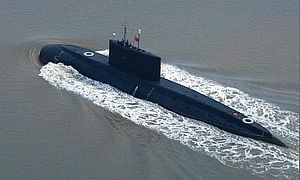If media reports are to be believed, the alarm bells in the Indian Ministry of Defence have been ringing again – the ministry was once again taken aback when a modern Yuan-class 335 conventional submarine crossed the Arabian Sea and entered Karachi port on May 22 for a week.
But such “surprises” had occurred earlier, when Chinese boats docked in Sri Lanka at the end of last year – upsetting India considerably – and yet again when the Chinese deployed a Shang-class nuclear submarine for anti-piracy patrols – a unique deployment unheard of in submarine operations. The unending saga of surprises never seems to cease, with little action on New Delhi’s part to respond to its growing concerns about the Chinese operating in an area perceived by many as India strategic backyard.
Indeed, India’s responses have been woefully inadequate, on the equipment front with thirteen aging submarines in its fleet (many of which are under repair) and a long delayed Scorpene project (with the first boat expected to roll out in 2016). The P75I project has yet to even get off the drawing board, hindered by strident calls for it to be a model “make in India” project, albeit with foreign help.
On the strategic front, a pusillanimous attitude towards participating in tri or quadrilateral naval exercises with the U.S., Australia and Japan have placed India in limbo, while attempts to get other friendly littorals within a common maritime security grid have produced mixed results.
To be fair, the Chinese are not doing anything illegal and as a growing maritime nation are only following in the footsteps of earlier rising powers Britain, the U.S., and the Soviet Union by expanding their “power projection” capabilities beyond their immediate waters into the strategically relevant Indian Ocean region. They are in effect following their maritime strategy of “going out” and building relationships across the region for the safety of critical sea lines of communication (SLOCs), while also projecting power. Moreover, Pakistan is scheduled to purchase eight of the modern Yuan-class submarines (Type 093A) and the recent visit would have been a good opportunity to display the operational performance of this class of boats to the buyers.
Many analysts have linked the frequent deployment of Chinese submarines in the Indian Ocean Region (IOR) with the unfolding strategic Great Game and the dynamics of the balance of power in the region. However, the question is whether individual Chinese submarines really do serve as “game changers” within the context of the regional dynamics.
It must be remembered that submarines, although they are force multipliers of sorts and create awe amongst adversaries, need to be deployed in constrained spaces such as choke points (whether virtual or real) or off harbors to be effective. Hence, submarines by themselves cannot be game changers in any real sense of the word. However, the Chinese are not just making forays with a few submarines; Beijing plans to build forward bases (virtual or real) for frequent naval deployments in the region while enhancing naval relations with South/Southeast Asian and East African countries in a bid to develop its famous “string of pearls” policy. Needless to say, in any such encirclement strategy, the role of China’s all-weather friend Pakistan will be stellar. Pakistan’s geographical location next to the Gulf, coupled with its growing economic dependence on China, has fostered an ideal symbiotic relationship that could well encourage deep naval partnership.
Interestingly, the Chinese Maritime Silk Route initiative, ostensibly proposed to create economic hubs in the ports of the region and exclusively for trade and economic purposes, may well help enhance maritime relations with these countries. Thus, the deployment of Chinese submarines is indicative of a larger game plan that seems to be unfolding and needs to be analyzed carefully.
Still, at the tactical level the deployment sent a strategic message, especially to the Indian security establishment, which has endlessly debated the implications of the Chinese naval forays into the IOR – specifically, that the People’s Liberation Army Navy has the ability to project and sustain its blue water reach, operating thousands of miles from its base for an extended period of time. Interestingly, the earlier Xia-class Chinese nuclear submarines were unable to operate for even short periods beyond nearby waters. The newer submarines are far superior technologically, with China reaffirming its prowess in creating high-tech weapons platforms.
Given that the Chinese submarines are likely to be found operating frequently in the IOR, the Indian defense establishment must develop some adequate responses, rather than just being alarmed repeatedly. The Ministry of Defence must probe China’s maritime vulnerabilities and stop bending to perceived Chinese apprehensions. At the inventory level it is necessary to reverse the nation’s depleting submarine strength by commencing the P75 I project, while enhancing ASW capabilities on surface ships. At the strategic level, India must encourage quadrilateral naval exercises in the Indian Ocean with its maritime partners, the U.S., Japan, and Australia and undertake expansive maritime relations with the littorals in the IOR. It must take a holistic view of the current developments and bolster naval partnerships in an attempt to get the friendly littorals into a security grid.
Dr. P K Ghosh is a Senior Fellow at the Observer Research Foundation. He is the former lead co-chair and India Representative to the CSCAP International Study Group on Naval Enhancement in Asia Pacific. He can be reached [email protected]

































